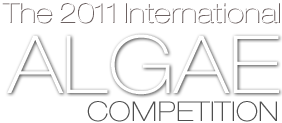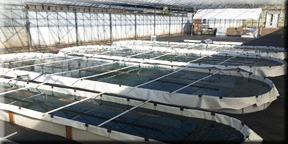Finalists • 1) Algae Landscape Design
These entries have been selected by our panel of jurors as first round FINALISTS in the International Algae Competition. The second round of jurying will select award winners.
CLICK ON IMAGE or Registration Number to see larger version of exhibit.
 1123. Video. Frederick Givins.
1123. Video. Frederick Givins.
Algae Powered Mushroom Farm in Congo, Africa.
A mobile algae powered mushroom farm can be placed anywhere in the world to support micro-economic development. Algae will be used as a food source and organic fertilizer for the mushrooms. Two target groups would be urban homeless and the poor of rural communities.
 1124. Isabelle Bardèche.
1124. Isabelle Bardèche.
AlgÔ, or the regeneration of the Baie de Morlaix by seaweeds.
This floating seaweed farm for Brittany in France is a fiber concrete structure with aerogel insulation and natural ventilation. AlgÔ will help clean the water, re-colonizing the bay with wildlife and transform the local economy. It will be a lab, a seaweed exhibition and visitor center.
 1139. Bi Yupeng.
1139. Bi Yupeng.
Algae School on Huiquan Bay, Qingdao China.
This public art installation for education and enlightenment is a transparent glass factory which uses haematococcus to produce astaxanthin. The transparent glass is overhead so visitors can enjoy the algae transforming its color dramatically during its growth.
 1142. David Edwards.
1142. David Edwards.
Ecologies of (Bio)Diversity: A Self Sustaining Tower for London.
The building is a living ecology. Algal ‘fields’ covering the facade absorb CO2 and produce bio-diesel for energy. The waste biomass through anaerobic digestion feeds the building skin. Waste water is sent through the algae, cleaning it for re use.
 1148. Yen Chang Huang.
1148. Yen Chang Huang.
Shoreline regeneration by algae cultivation in Cigu, Taiwan.
A Sinking Shore Story. Historically, Taijiang Inland Sea was surrounded by seven offshore sandbanks, home to thousands of fishing boats. Now lagoon and sandbanks are disappearing. Algae is the base of the coastal food chain and is needed to build an new shoreline ecosystem.
 1149. Kathryn Hier.
1149. Kathryn Hier.
Green Miles. I-40 near Knoxville, Tennessee.
Using the negative outputs of gasoline as catalysts for bio-fueled transportation, relying on coniferous trees and algae. The goals are to offset carbon emissions, recharge aquifers and provide bio-fuels from an algae bioreactor system on the side of the interstate infrastructure.
 1159. Chen Jie & Gong Ying.
1159. Chen Jie & Gong Ying.
Algae Energy Exhibition Park, Jingzhou, Hubei, China.
The site along the Hanjiang river was a coal-fired power plant, with coal ash covering 50% of the whole area, severely impacting air, land and water quality. The design of the algae energy park is to provide the public a comfortable park and popularize alternative energy technology.
 1161. Aleksandrina Rizova & Richard Beckett.
1161. Aleksandrina Rizova & Richard Beckett.
[Infra]Structural Algae Ecology for Taipei, Taiwan.
Rain-water will be harvested through the porous urban fabric and recycled for horizontal and vertical farming. Algal photo-bioreactor towers will collect CO2 from vehicles and buildings. Horizontal layers of hydroponics systems will provide food for the city.
 1164. Sean Quinn.
1164. Sean Quinn.
Process Zero: Retrofit Resolution. Federal Building, Los Angeles.
Goal is to design zero environmental footprint, energy self-sufficiency for existing building using Living Building Challenge 2.0 guidelines. A modular system of algae tubes wrap the building and absorb the sun’s radiation to produce lipids for fuel production and shade the interior office spaces.
 1165. Federico Curiél.
1165. Federico Curiél.
ALGAL&SCAPE: Study of polder Schieveen, Rotterdam, Netherlands.
A sustainable strategy for large scale micro-algae harvesting using the polders, reclaimed land enclosed by dykes. The Netherlands could benefit from this transformation of the polders, ensuring enough production of fuel for the Dutch needs and even more to be stored or exported.
 1170. Chew Teik Hee.
1170. Chew Teik Hee.
PAM (Persatuan Arkitek Malaysia) Centre, Malaysia
As a living entity this building becomes the breathable Malaysian Institute of Architects. The outer skin is a glass shell structure reinforced with octagonal frames and perforated with controllable openings. Modular bio-reactor panels are along the inner facade and algae within the panels.
 1171. Kady, Wong Hoi Kei & Kate, Lau Hoi Ying & Perry Li.
1171. Kady, Wong Hoi Kei & Kate, Lau Hoi Ying & Perry Li.
Urban Algae Culture in Gangxiacun, Shenzhen China.
The Urban River from waste to source. Masterplan for an urban village of 20,000 people in Shenzhen city of 14 million people. Redesign with an elevated urban river roofscape, greening with modular algae units for waste treatment and fuel production, urban farming, community space.
 1172. Video. Squared Design Lab: & Höweler+Yoon Architecture.
1172. Video. Squared Design Lab: & Höweler+Yoon Architecture.
Eco-Pod: Pre-Cycled Modular Algae Bioreactor, Boston.
Eco-Pod is a temporary vertical algae bioreactor and public commons, built with custom prefab modules. The pods are biofuel sources and micro-incubators for R&D programs. This is anticipatory architecture, generating a micro-urbanism that is local, agile, and carbon net positive.
 1173. Adrian Yee Cheung Lo.
1173. Adrian Yee Cheung Lo.
Carbon Dioxide Eliminating Floating Green Park, Hong Kong.
Rule of Nature: Waste is Food. The site is a shore front express way next to the dense urban residential developments in Hong Kong. A CO2 collector system integrated with noise barrier. Car exhaust CO2 is pumped to algae cell modules for hydrogen-producing marine algae.
 1179. Ho Wing Ho.
1179. Ho Wing Ho.
Production Landscape for warm coastal areas of the world.
The offshore algae cell farm powers the city nearby and its by-products benefit onshore agriculture. Rings of floating hydrogen producing algae cells in daytime produce electricity and are inflated by gases. At night, the gases inflate onshore greenhouses as heat for plants inside.
 1180. Heather Ring, Brenda Parker, Synnove Fredericks.
1180. Heather Ring, Brenda Parker, Synnove Fredericks.
Algaegarden celebrates the beauty and productive potential of algae.
Algaegarden leads the visitor to appreciate algae both as an alternative to oil and a source of food and nutrition. Bicycle pumps invite visitors to participate in the aerating the algae. The garden was selected to be part of the 2011 Metis International Garden Festival in Quebec.
 1182. Judit Aragonés Balboa.
1182. Judit Aragonés Balboa.
Alga Therapeia Center, San Sebastian, Spain.
Design for a research center of marine algae typical of the Basque
coast for medicinal, food and industrial applications. A photobioreactor skin generates the necessary energy for all building operations: therapy baths, solarium, kitchens, classrooms, research laboratory.
 1185. Mark Buehrer, 2020 Engineering Inc.
1185. Mark Buehrer, 2020 Engineering Inc.
Eco Laboratory: Phase II Algae Microfarm Center, Seattle.
The Algae Microfarm Center is the heart of the community. A living building with algaculture, hydroponics, aquaculture, aeroponics, aquaponics and farming. Includes rooftop garden, algae bioreactors, farmers market, community gardens, orchards and greenhouses.
 1186. Thomas Kosbau.
1186. Thomas Kosbau.
Hydral Housing units with modular hydrogen producing panels.
Modular panels of hydrogen producing algae can be placed like photo-voltaics. This second skin of algae panels constructs a quilted mosaic of color. Housing units create fresh water and reduce carbon emissions, without requiring occupants to change energy-consuming habits.
 1190. Video. Influx_Studio, Mario Caceres, Christian Canonico.
1190. Video. Influx_Studio, Mario Caceres, Christian Canonico.
Green Loop: Marina City Global Algae Retrofitting, Chicago.
Algae proposal for one of the most innovative buildings in the Loop of Chicago: Marina City Towers. Aligned with the Chicago Climate Action Plan (2008), goal is to showcase algae with green technologies and clean polluted air, reuse waste water, produce energy and food onsite.
Contributing Sponsors
 Evodos BV Separation Excellence. Totally Dewatering Algae. Alive. The ideal interface between growing and refining. It is Evodos’ mission to support our customers with the best products for mechanical separation at minimal energy consumption without chemicals or consumables.
Evodos BV Separation Excellence. Totally Dewatering Algae. Alive. The ideal interface between growing and refining. It is Evodos’ mission to support our customers with the best products for mechanical separation at minimal energy consumption without chemicals or consumables.
 NanoVoltaics (NVI) is an engineering services provider to the cleantech sector, focusing on commercialization of disruptive technologies and production methods. Nanotechnology offers solutions to the world’s resource problems and novel products for photovoltaics and biofuels.
NanoVoltaics (NVI) is an engineering services provider to the cleantech sector, focusing on commercialization of disruptive technologies and production methods. Nanotechnology offers solutions to the world’s resource problems and novel products for photovoltaics and biofuels.
 SmartMicrofarms technology will enable people globally to grow healthy foods locally, using affordable inputs. We research, develop, demonstrate, diffuse, and support flexible microcrop platforms that produce food and valuable co-products locally.
SmartMicrofarms technology will enable people globally to grow healthy foods locally, using affordable inputs. We research, develop, demonstrate, diffuse, and support flexible microcrop platforms that produce food and valuable co-products locally.
 AlgaeAlliance.com members Robert Henrikson and Mark Edwards are the creators and developers of this International Algae Competition. Their purpose is to expand and share a vision for algae in our future and create an open source algae community and collaboratory.
AlgaeAlliance.com members Robert Henrikson and Mark Edwards are the creators and developers of this International Algae Competition. Their purpose is to expand and share a vision for algae in our future and create an open source algae community and collaboratory.

 SF Bay Area Spirulina Microfarm
SF Bay Area Spirulina Microfarm



